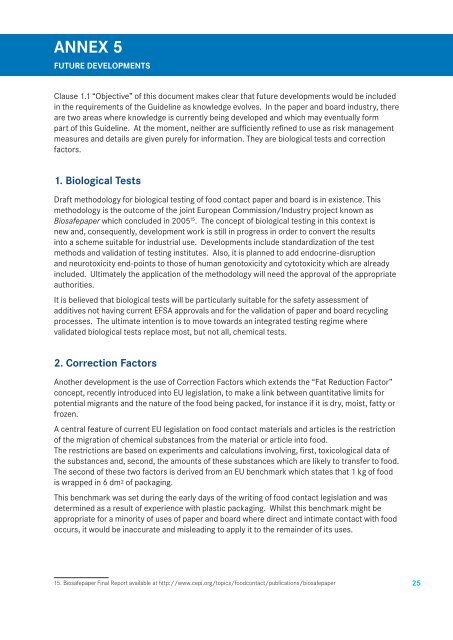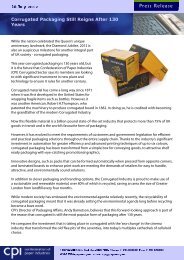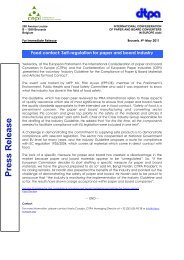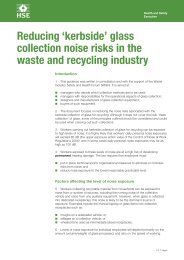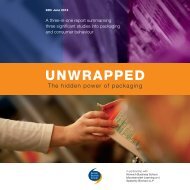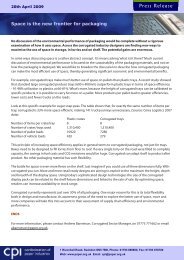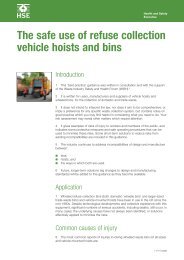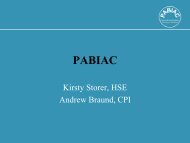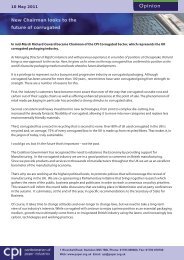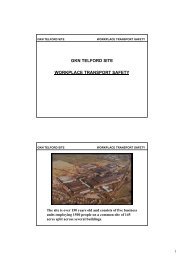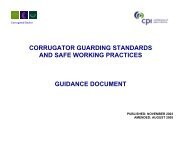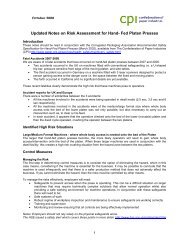Industry guideline for the Compliance of Paper & Board ... - cepi
Industry guideline for the Compliance of Paper & Board ... - cepi
Industry guideline for the Compliance of Paper & Board ... - cepi
You also want an ePaper? Increase the reach of your titles
YUMPU automatically turns print PDFs into web optimized ePapers that Google loves.
Annex 5<br />
Future developments<br />
Clause 1.1 “Objective” <strong>of</strong> this document makes clear that future developments would be included<br />
in <strong>the</strong> requirements <strong>of</strong> <strong>the</strong> Guideline as knowledge evolves. In <strong>the</strong> paper and board industry, <strong>the</strong>re<br />
are two areas where knowledge is currently being developed and which may eventually <strong>for</strong>m<br />
part <strong>of</strong> this Guideline. At <strong>the</strong> moment, nei<strong>the</strong>r are sufficiently refined to use as risk management<br />
measures and details are given purely <strong>for</strong> in<strong>for</strong>mation. They are biological tests and correction<br />
factors.<br />
1. Biological Tests<br />
Draft methodology <strong>for</strong> biological testing <strong>of</strong> food contact paper and board is in existence. This<br />
methodology is <strong>the</strong> outcome <strong>of</strong> <strong>the</strong> joint European Commission/<strong>Industry</strong> project known as<br />
Biosafepaper which concluded in 2005 15 . The concept <strong>of</strong> biological testing in this context is<br />
new and, consequently, development work is still in progress in order to convert <strong>the</strong> results<br />
into a scheme suitable <strong>for</strong> industrial use. Developments include standardization <strong>of</strong> <strong>the</strong> test<br />
methods and validation <strong>of</strong> testing institutes. Also, it is planned to add endocrine-disruption<br />
and neurotoxicity end-points to those <strong>of</strong> human genotoxicity and cytotoxicity which are already<br />
included. Ultimately <strong>the</strong> application <strong>of</strong> <strong>the</strong> methodology will need <strong>the</strong> approval <strong>of</strong> <strong>the</strong> appropriate<br />
authorities.<br />
It is believed that biological tests will be particularly suitable <strong>for</strong> <strong>the</strong> safety assessment <strong>of</strong><br />
additives not having current EFSA approvals and <strong>for</strong> <strong>the</strong> validation <strong>of</strong> paper and board recycling<br />
processes. The ultimate intention is to move towards an integrated testing regime where<br />
validated biological tests replace most, but not all, chemical tests.<br />
2. Correction Factors<br />
Ano<strong>the</strong>r development is <strong>the</strong> use <strong>of</strong> Correction Factors which extends <strong>the</strong> “Fat Reduction Factor”<br />
concept, recently introduced into EU legislation, to make a link between quantitative limits <strong>for</strong><br />
potential migrants and <strong>the</strong> nature <strong>of</strong> <strong>the</strong> food being packed, <strong>for</strong> instance if it is dry, moist, fatty or<br />
frozen.<br />
A central feature <strong>of</strong> current EU legislation on food contact materials and articles is <strong>the</strong> restriction<br />
<strong>of</strong> <strong>the</strong> migration <strong>of</strong> chemical substances from <strong>the</strong> material or article into food.<br />
The restrictions are based on experiments and calculations involving, first, toxicological data <strong>of</strong><br />
<strong>the</strong> substances and, second, <strong>the</strong> amounts <strong>of</strong> <strong>the</strong>se substances which are likely to transfer to food.<br />
The second <strong>of</strong> <strong>the</strong>se two factors is derived from an EU benchmark which states that 1 kg <strong>of</strong> food<br />
is wrapped in 6 dm 2 <strong>of</strong> packaging.<br />
This benchmark was set during <strong>the</strong> early days <strong>of</strong> <strong>the</strong> writing <strong>of</strong> food contact legislation and was<br />
determined as a result <strong>of</strong> experience with plastic packaging. Whilst this benchmark might be<br />
appropriate <strong>for</strong> a minority <strong>of</strong> uses <strong>of</strong> paper and board where direct and intimate contact with food<br />
occurs, it would be inaccurate and misleading to apply it to <strong>the</strong> remainder <strong>of</strong> its uses.<br />
15. Biosafepaper Final Report available at http://www.<strong>cepi</strong>.org/topics/foodcontact/publications/biosafepaper<br />
25


